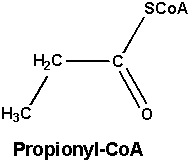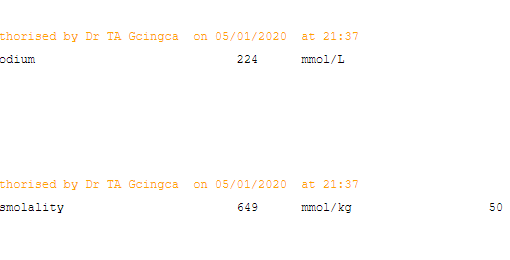| Ward | Pollsmoor Female Centre | D.O.B/Age | 10/10/1988 |
| Consultant |
Abnormal result
Creatine kinase (CK) 265 070 H U/L 20 – 180
Presenting complaint
Request form: Unable to obtain on Equation document viewer. Differential diagnosis in this patient includes rhabdomyolysis, severe burns, myocardial injury or ischaemia.
History
Unavailable.
Examination
Unavailable.
Laboratory investigations
Sodium 139 mmol/L 136 – 145
Potassium 3.8 mmol/L 3.5 – 5.1
Urea 2.6 mmol/L 2.1 – 7.1
Creatinine 63 umol/L 49 – 90
eGFR (MDRD formula) >60 mL/min/1.73 m2
Total protein 76 g/L 60 – 78
Albumin 46 g/L 35 – 52
Total bilirubin 6 umol/L 5 – 21
Conjugated bilirubin (DBil) 2 umol/L 0 – 3
Alanine transaminase (ALT) 317 H U/L 7 – 35
Aspartate transaminase (AST) 1727 H U/L 13 – 35
Alkaline phosphatase (ALP) 153 H U/L 42 – 98
Gamma-glutamyl transferase (GGT) 43 H U/L <40
Other investigations
Folder unavailable. No treating doctor listed.
Final diagnosis
Rhabdomyolisis (most likely secondary to blunt force trauma).
Take-home messages
Creatine kinase is an enzyme primarily found in muscle tissue that catalyzes the conversion of creatine and adenosine triphosphate (ATP) into phosphocreatine and adenosine diphosphate (ADP). This reaction is reversible and thus phosphocreatine serves as a rapidly available source of ATP. When muscle tissue is stressed or inflamed, the sarcoplasmic membrane becomes permeable and leaks cytosolic enzymes like creatine kinase into the bloodstream. The differential diagnosis of an elevated CK concentration is long and complex. Musculoskeletal trauma, myocardial injury, infections, and drug-induced myositis are the most common causes encountered in general clinical practice. Aso worth noting in this patient is the AST is markedly elevated in comparison to the other liver enzymes. This, coupled with the elevated CK levels imply that quite significant muscle damage has occurred.
Making dilutions when results are appearing as having a greater than value on the analyzer is important. Creatine kinase is an enzyme that may be used to monitor the clinical condition of a patient. It may thus be useful to know exact values to be able to determine ongoing damage vs resolution. By preparing samples in dilution, this allows for a relatively accurate determination of the concentration of an analyte of interest by overcoming large reagent requirements.





